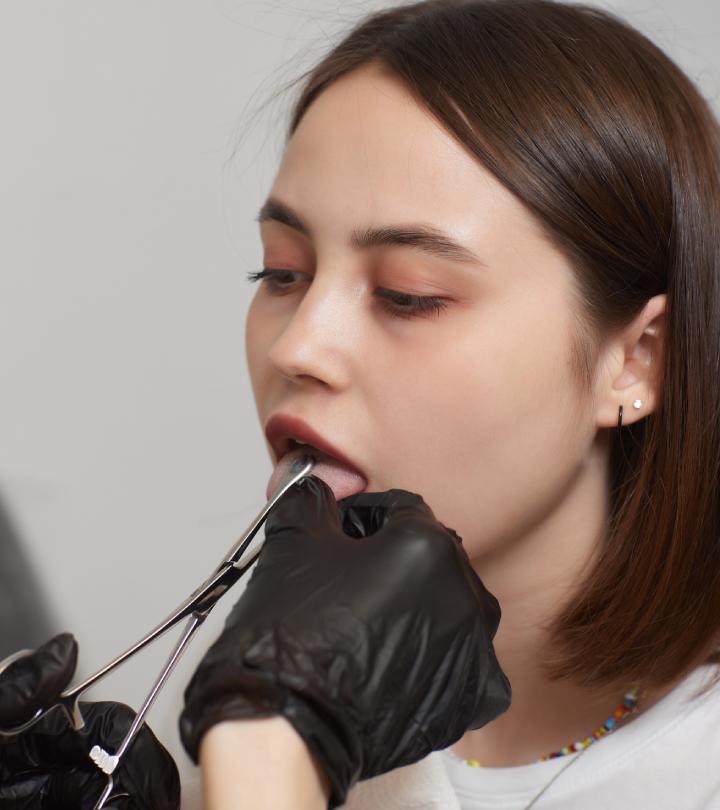Can Teachers Have Tattoos? Everything You Need To Know
The key to maintaining a balance between self-expression and classroom professionalism.

Image: Shutterstock
Tattoos are everywhere these days, including a school setting. As the prevalence of tattoos increases, so does the conversation around what is acceptable for professionals such as teachers and what is not. Can teachers have tattoos? What rules should they abide by? What are the advantages and disadvantages? The debate on this topic touches upon the appropriateness of tattoos, personal preferences, and the definition of professionalism within the context of school premises. It is about more than just fashion or trends; it is about how educators can express themselves while staying true to their role. We are seeing a shift in the conversation now as staff dress codes are not as rigid and a teacher’s tattoo might just be another aspect of their identity, such as the books they carry or the subjects they are passionate about.
In this article, we look at how teacher’s tattoos intersect with the teaching profession and what that means for school systems and students’ perceptions. Let us dive into a changing world where education meets personal expression and understand how and where tattoos fit in it.
In This Article
Can Teachers Have Tattoos?
A conversation on whether teachers can have tattoos is a reflection of the broader society’s evolving views on body art and the generational factor. Today, it is common for educators to have tattoos, signaling a generational shift towards greater acceptance of individual expression within school officials’ policies on tattoos (1).
In many educational institutions, teacher tattoos are accepted, provided they are not offensive or distracting. Schools often consider the age group of the students and may be more permissive with elementary school teachers who instruct older students. However, primary school teachers may face stricter regulations due to the potential for upsetting students and their perception of tattoos.
Each school or district typically sets its own policy which serves as the dress code policy regarding tattoos on teachers. These policies might include stipulations such as requiring tattoos to be covered during school hours or allowing small, non-offensive tattoos to be visible. The main objective is to maintain a professional learning environment while also considering appearance-based discrimination and professional norms.
School dress codes and guidance on staff tattoos are particularly important in the public school district environment, where the community’s traditional norms may influence the staff dress code. It is important for teaching staff to carefully review and comply with their school’s policy on teacher tattoos, which can usually be found in the employee handbook or by consulting with the administration. That way, they can ensure their personal expressions via tattoos do not interfere with their professional responsibilities as teachers at school.
 Fun Fact
Fun FactLet us break it down into different levels of schooling to understand how tattooing and teaching can go hand-in-hand. Considering factors like religious reasons and the wider perception of tattoos in society can help us gain a holistic perspective.
1. Can Preschool Teachers Have Tattoos?
In early childhood education, whether preschool teachers can have tattoos is something that each school addresses based on its culture and the preferences of the families they cater to. Preschool is a child’s first formal introduction to the world of learning, and many schools focus on creating an environment that’s as neutral and nurturing as possible, adhering to a strict school dress code.
For teachers with tattoos, this does not mean their body art is problematic. It means there is a balance to be struck. Preschools often request that teachers cover their tattoos to ensure that the visual focus for children remains on the educational materials and classroom activities rather than on personal decoration. This can be as simple as wearing a long-sleeved shirt or a skin-toned bandage over smaller tattoos.
Jennifer, a teacher and blogger, wrote about how she got inked and shared her experience: “My first tattoo was a meditation knot for teachers — and I am one. I had only been a teacher for a few years when I got that tattoo, and I suppose it was prescient since I have remained one for 30 years (i).”
However, this is not just about hiding teacher tattoos; it is about presenting a professional, consistent image that aligns with the educational philosophy and standards of the preschool. As society continues to embrace people with tattoos, more schools are evaluating their policies on tattoos to allow for greater potential for future expression. For now, though, many preschool educators with tattoos find creative ways to comply with their school’s guidelines while still feeling true to themselves.
2. Can Elementary School Teachers Have Tattoos?
As children head into their elementary years, the question of whether their elementary school teachers can have tattoos becomes a bit less black and white. For elementary teachers, the answer varies widely. Schools often weigh the maturity of the students and the community’s culture when making decisions about such policies. Generally speaking, elementary teachers with tattoos may be asked to cover them up, but this is not always the case.
Some elementary schools have adopted more relaxed attitudes, recognizing that a teacher’s tattoo design doesn’t necessarily hinder their ability to teach as long as it is appropriate. In these environments, visible tattoos might be seen as an avenue to teach students about self-expression and the importance of not judging others by their appearance, challenging the old definition of professionalism.
That said, when asking, ‘Can teachers have tattoos?’, the most prudent step for elementary school teachers is to check the specific guidelines on staff tattoos in their school. While there is growing acceptance, there is still an expectation for teachers to present themselves in a way that is considered professional and conducive to a focused learning atmosphere within the school setting.
In simpler terms, elementary school teachers can have tattoos, but they should ensure they are in line with the school’s dress code policy and respectful of their role as educators.
3. Can Online Teachers Have Tattoos?
Regarding the virtual classroom, school leaders often allow more flexibility when it comes to tattoos on people in teaching roles as the classroom setting is not physical but digital. The digital barrier between students and teachers naturally puts less emphasis on personal style and more on educational content. So, can teachers have tattoos if they are teaching online? More often than not, the answer leans toward a yes since student perceptions and professional norms may differ online.
That said, online teachers should still consider their on-camera appearance and maintain a professional environment. While a tattoo might peek out during a lesson, as long as it is not considered an inappropriate tattoo, it should not be a problem. The teacher’s tattoo in question should not be offensive or excessively distracting. It should align with the professional norms set forth by the educational institution.
Online teaching offers a bit more freedom for teachers to express themselves with body art thanks to the prevalence of tattoos in society and a more open-minded approach.
In summary, teaching staff, including senior staff and classroom teachers, can have tattoos, but whether they can wear it with pride or need to hide it cleverly depends on the school’s or district’s dress code policy. Notably, school boards and senior staff may be involved in establishing these policies, often influenced by traditional norms regarding body art.
Next, let us take a look at how the attitudes of school leaders and policies about tattoos on people in educational roles may vary from one region to another across the world.
Tattoo Policies For Teachers Across The World
Globally, the stance on whether teachers can have tattoos is as diverse as the cultures themselves. Let us take a glance at how the question of teachers and tattoos is approached in different corners of the world.
The United States Of America
In the US, local school districts often set the tattoo policy for teachers, meaning there is no one-size-fits-all rule. Some districts are pretty relaxed, fostering an environment where teachers’ tattoos do not raise eyebrows, provided they are not offensive. Meanwhile, more conservative areas might require teachers to keep their ink under wraps.
Europe
In the UK too, teachers with tattoos aren’t uncommon, and there’s a growing acceptance, albeit with a nod to discretion and professionalism. Across the Channel, some countries such as France embrace a more open view on them and accept tattoos unless they clash with the school’s values.
Canada
In Canada, acceptance of teacher tattoos can be region-specific. While urban centers might be more liberal, rural districts could expect teachers to cover their body art.
Australia
In Australia, teacher tattoos are allowed, but they must be aware of school district policies regarding visible tattoos and ensure that the artwork is not inappropriate or offensive.
Asia
You will find stricter policies in Asia. In Japan and South Korea, for instance, visible tattoos can hinder a teacher’s career prospects due to strong cultural taboos associated with inked skin (2). Indian teachers are allowed to have tattoos, provided that their body art is not offensive or disrespectful and is concealed while teaching. However, some schools may have regulations that prohibit visible tattoos for their staff members.
Middle East
Cross into the Middle East, and the policies tighten even further. Here, tattoos might not only be frowned upon in teaching roles but could also go against local customs and laws. Tattoos are prohibited by law in Saudi Arabia, and individuals can face penalties such as fines or imprisonment for getting one. Similarly, in Iran, having a tattoo is considered an act of rebellion against the government and can result in imprisonment.
Africa
In some parts of Africa such as Nigeria, tattoos are viewed negatively because they are associated with gangs and other criminal organizations.
So, can teachers have tattoos? It really depends on where you are teaching and the prevailing cultural norms. The key takeaway for a teacher with tattoos or considering them is to research local attitudes and school policies to ensure their personal art doesn’t draw the curtain on their teaching aspirations.
 Did You Know?
Did You Know?If you work in a country or school space that warrants you to conceal your tattoos, here is how you can do it.
How Can Teachers Cover Up Tattoos?
Teachers who embrace body art but work in environments where tattoos need to be out of sight have a few tricks up their sleeve—quite literally. If you are a teacher pondering how to navigate the school’s dress code while honoring your personal style, here are some practical tips for concealing your tattoos during work hours.
First up, clothing is your best ally. Long sleeves, higher necklines, or pants can be stylish and professional while keeping your ink undercover. Lightweight layers can be a game-changer for warmer days or more active lessons. Think thin cardigans or even compression sleeves, which can be particularly comfortable.
Makeup is another handy option. Nowadays, numerous products on the market are designed specifically to cover tattoos. Look for high-coverage concealers and foundations, ensuring they are smudge and transfer-resistant so your secret stays safe, even during recess duty.
And then there’s the classic bandage or skin-toned medical tape. It’s a no-fuss solution, especially for smaller tattoos. Just stick it on, and you’re good to go. The key is to find a shade that blends well with your skin tone so that it draws as little attention as possible.
As the education sector evolves, the question, “Can teachers have tattoos?” becomes more and more common, and many schools are adapting their policies accordingly. Until the day when your ink can openly be part of your teacher identity, these cover-up strategies can help you meet the dress code without compromising your individuality. Some even get it removed so as to prevent further negative conversation and image (3).
We have gone through various cover-up methods. Let us take a look at the different pros and cons of having teachers with tattoos teaching in the next section.
Teachers With Tattoos: Pros And Cons
Teachers with tattoos can often find themselves at the center of a spirited discussion about classroom appropriateness and personal expression. Let us take a look at the advantages and challenges that tattooed educators might face.
Pros Of Teachers Having Tattoos
- Make The Teacher Seem Approachable: Tattoos can help students see teachers as more approachable, bridging the gap between generations. This connection can enhance the teacher-student relationship, fostering a stronger educational bond.
- Help Inspire The Students: They are a form of self-expression that can inspire students to embrace their uniqueness. Teachers’ tattoos often tell a story or represent personal beliefs that can intrigue and engage students.
- Help Start A Conversation: Ink can open up discussions about cultural significance, personal milestones, and art. These dialogues can enrich classroom dynamics and promote critical thinking about societal norms.
- Help Promote Inclusivity: Visible teacher tattoos can challenge stereotypes, promoting a more inclusive environment where diverse backgrounds are celebrated. It demonstrates to students the importance of accepting different forms of self-expression.
- Help Teach Life Lessons: They can be used to teach about the history and societal perceptions of body art. This can integrate real-world teachings into curriculum subjects like history, sociology, and art.
Cons Of Teachers Having Tattoos
- May Lead To Stigma: Despite changing attitudes, some communities still view tattoos negatively, which affects perceptions of professionalism. This stigma can create hurdles in job prospects and acceptance within the school community.
- May Cause Distraction: Students might focus more on a teacher’s tattoos than on the lesson at hand. This could potentially disrupt the learning environment, especially if the tattoos are elaborate or extensive.
- May Raise Professionalism Concerns: There is an ongoing debate on whether tattoos are compatible with professional standards, which may impact a teacher’s authority and credibility. This may challenge a teacher’s capacity to enforce discipline in certain educational settings.
- May Go Against Policy Guidelines: Teachers often need to follow dress codes or policies that may require them to cover tattoos, limiting their freedom of self-expression. These restrictions can lead to discomfort or issues with self-identity for teachers.
- May Not Match Parental Expectations: Parents may hold conservative views on tattoos, which can lead to potential objections or discomfort with tattooed educators. Teachers may have to navigate difficult conversations or justify their ability to educate despite their body art (1).
In an evolving educational landscape, teachers with tattoos continue to balance personal identity with their communities’ varying professional and cultural expectations.
 Trivia
TriviaThis also warrants a look at how teachers with tattoos influence students and their opinions about the world in general. Check out the next section to learn more.
How Teachers With Tattoos Influence Students?
When we talk about the impact of teachers on students, their personal style, including tattoos, often comes into the conversation. The presence of ink on a teacher’s skin can influence students in a variety of ways.
For starters, a teacher with tattoos can inadvertently become a role model for self-expression. Students observing their teachers feeling confident and unapologetic about their body art might feel encouraged to express their own personalities more freely. This can be incredibly empowering in a formative environment where young people are still figuring out their identities.
Moreover, inked educators can help dismantle outdated stereotypes. Students who see teachers with tattoos excelling in their roles learn that competence and professionalism are not exclusively tied to a traditional look. This promotes an understanding of diversity in professional settings.
However, it is crucial to consider the other side of the coin. In classrooms where tattoos are a novelty, they might distract students from the lesson. The intrigue surrounding a teacher’s art can lead to a focus shift, especially if the tattoos are elaborate or carry a strong visual impact.
The discussion around “Can teachers have tattoos?” often extends beyond faculty policies into the realm of student influence. When teachers choose to display their tattoos, they walk a line between staying true to themselves and being mindful of their impact on impressionable minds. However, it can be a powerful form of silent mentorship when done thoughtfully.
Young impressionable minds can be molded to look at tattoos in a positive light by tattooed teachers. Even so, there are many reasons teachers are discouraged from getting tattooed still. Some of them are discussed below.
Reasons Teachers Should Avoid Getting Tattoos
While the debate around whether educators can flaunt inked skin continues, there are a few reasons teachers might consider steering clear of getting tattoos, especially if they are in a visible spot.
- Despite a shift towards greater acceptance, tattoos can still stir up controversy in school environments. Whether it’s due to district policies or personal opinions, especially from parents, prominent tattoos may awkwardly place teachers under the microscope and potentially affect their professional image.
- Another reason is the potential for distraction. A colorful sleeve or large graphic tattoo might command more attention than intended, diverting students’ focus from the subject matter. It’s crucial for teachers to maintain an environment where learning is the primary focus, and sometimes, even the most artistic tattoos can challenge that. It can also encourage students to get their own tattoos in the future and may change the view of how society perceives them (4).
- In culturally diverse classrooms, tattoos might be interpreted in ways that do not align with every student’s or their family’s cultural or religious beliefs. Teachers need to navigate this sensitive terrain carefully to ensure that their personal expressions, such as tattoos, do not inadvertently disrespect or alienate any of their students’ cultural values (2).
- Tattoos can potentially limit where a teacher can work, especially as some schools, districts, and regions may have more stringent appearance standards. This is an important consideration for teachers seeking future opportunities in different educational settings where visible tattoos could be a barrier to employment.
- Lastly, the permanence of tattoos means thinking long-term, and in the ever-changing landscape of education, what is acceptable now might not be in the future. The question, “Can teachers have tattoos?” doesn’t have a static answer, and trends can shift, possibly leaving teachers with visible tattoos in a tough spot if policies tighten up.
While personal expression is valuable, teachers contemplating tattoos might consider these points to ensure their choice aligns with their commitment to providing a distraction-free educational experience.
Whether teachers can have tattoos cannot be answered with a simple yes or no. This debate invites us to consider a spectrum of opinions and policies that exist across schools worldwide.
While some educators proudly display their body art as a form of self-expression and a tool for fostering inclusivity, others opt for discretion to align with school policies or societal expectations. The most important takeaway is that tattoos are a personal choice and one that requires careful thought in the context of a teacher’s professional life. As tattoos become more commonplace, watching how schools continue to adapt their policies will be interesting. Whatever the case, the quality of teaching remains paramount, far above what a teacher chooses to ink on their skin.
Frequently Asked Questions
Are there any other things related to tattoos that teachers should keep in mind?
Yes. Educators must consider the cultural and societal expectations of the community in which they teach. The visibility and content of a tattoo can impact a teacher’s professional image. Discreet tattoos that do not depict anything offensive are more likely to be accepted in educational systems.
Do tattoos affect a teacher’s hiring prospects?
Yes. Tattoos may impact teacher hiring, especially if visible during an interview or if the school has a strict dress code. Teachers with tattoos may need to assure the school that their tattoos won’t conflict its values or create distractions in the learning environment.
Are there any specific types of tattoos that are considered inappropriate for teachers?
Yes. Inappropriate tattoos for teachers include those that are explicit, offensive, or controversial. Tattoos depicting violence, discrimination, or adult themes may lead to objections from parents or school leaders, affecting a teacher’s position in the school.
Do private schools have different policies regarding tattoos for teachers?
Yes. Private schools have their own rules that differ from public schools, which can be more conservative due to traditional or religious norms. Teachers considering private schools should review their policies since they can vary significantly.
Key Takeaways
- Tattoos are being increasingly accepted in teaching, but appropriateness varies by school policy and community standards.
- Tattoos in teaching are subject to school policies, which reflect local cultural norms and professional standards.
- Visible, non-offensive tattoos may be permitted, yet some schools mandate they be covered during teaching hours.
- Teachers’ tattoos can influence hiring and career advancement, especially in positions requiring community interaction.
- Teachers should review and adhere to specific school tattoo guidelines to ensure compliance and professionalism.
Teachers with tattoos are becoming more and more popular and getting accepted. This informative video explains the experience of a teacher with tattoos, how it is a conversation starter with kids, and what guidelines need to be followed as a tattooed teacher. Scroll down to watch it.
Personal Experience: Source
StyleCraze's articles are interwoven with authentic personal narratives that provide depth and resonance to our content. Below are the sources of the personal accounts referenced in this article.
(i). A New Tattoo To Illustrate The Ineffablehttps://adoptsomom.wordpress.com/
References
Articles on StyleCraze are backed by verified information from peer-reviewed and academic research papers, reputed organizations, research institutions, and medical associations to ensure accuracy and relevance. Read our editorial policy to learn more.
- Cultural Models Of Bodily Images Of Women Teachers
https://www.mdpi.com/2075-4698/2/4/252 - Tattoo And Taboo: On The Meaning Of Tattoos In The Analytic Processm
https://www.tandfonline.com/doi/abs/10.1111/j.1745-8315.2011.00497.x - Complications Of Tattoos And Tattoo Removal: Stop And Think Before You Ink
https://www.ncbi.nlm.nih.gov/pmc/articles/PMC4411590/ - Tattoos
Piercing And Sexual Behaviors In Young Adults
Read full bio of Subhrojyoti Mukherjee
Read full bio of Pahul Nanra






























